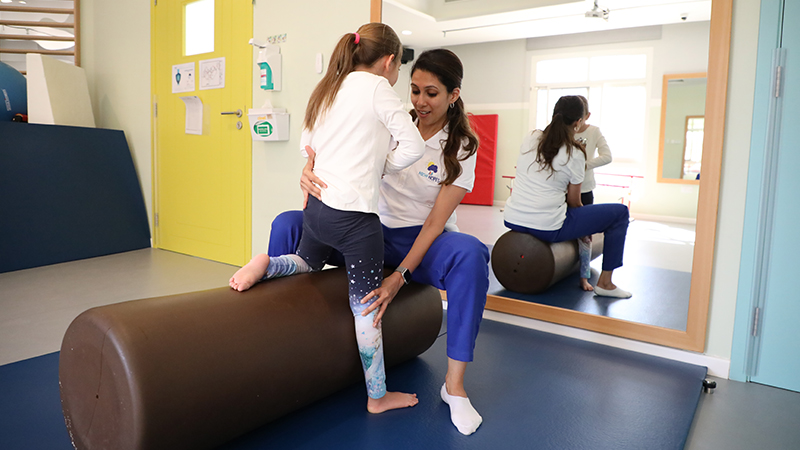Think about how it feels to hold your child when they are fast asleep versus when they are clinging to you. The more activation, the lighter your child feels and the easier it is to move them. It is that feeling when you have to make your way out of a cozy couch you have been sitting on for hours and then when you struggle to stand up and answer the doorbell. That is the same sense of inertia and heaviness our children with HYPOTONIA experience.
Matter of tone
Hypotonia is a medical term used to describe decreased muscle tone. Normally, even when relaxed, muscles have a very small amount of contraction or tension that gives them a springy feel and provides some resistance to passive movement. Hypotonia refers to decrease in the resting tension of the muscle. Depending on the severity of hypotonia, the child’s muscles feel soft and floppy. Low tone is not the same as muscle weakness, although the two conditions can co-exist. Children with hypotonia work harder to keep themselves upright against gravity.
What comes to us naturally is what kids with low tone have to battle against constantly.
Its origin
While almost all children with cerebral palsy start life with a period of hypotonicity (Prectyl, Kong) and progress to hypertonia or spasticity, there is a group of children that remain floppy throughout life. Hypotonia in this article is largely referring to low tone of central origin that occurs with diseases of the brain, cerebellum, brainstem, and spinal cord. Very often, central hypotonia co-exists with abnormalities of movement such as ataxia or dyskinesia. Pathological processes such as trauma, metabolic disorders, chromosomal and genetic abnormalities, and degenerative diseases can also create floppy muscle tone. Apart from children with a more specific “motor” diagnosis, there are many children with challenges who display minimal hypotonia such as children with learning disability, sensory processing disorder, or children with minimal brain dysfunction.
The Indicators
You may notice some of the following signs in a child with hypotonia:
- Child feels limp when carried, as if they would slip away from your hands
- Do not prefer tummy time
- A weak cry or a quiet voice
- Rounded, slouched, and open mouth posture
- Leaning on supports
- W sitting position is favored on floor
- Fatigues quickly or gives up easily
- poor core strength and stability
- Hypermobile joints
- Preference for sedentary activities
- Finding difficulty sucking/swallowing
- Difficulties with fine motor skills like writing or coloring
- Lack of attention and motivation
- Takes longer time to process information
Posture and Movement Challenges
The child has difficulty turning on the muscle activity throughout their body and struggles generating a force and holding that force production for longer periods against gravity. For instance, when a baby is working on tummy time they have to turn their muscles on to lift their head up, off the support surface – to do that they need to be able to generate enough force so that their muscles can turn on and lift the head. Once they have their head lifted, they need to be able to keep that force turned on long enough so that they can look around. The movements initiated are often sudden, abrupt, and rapid lacking grading and control. The tummy and back muscles do not work together for postural control and stability.
Gravity has a great impact on the rib cage of infants and children who prefer to be in lying position most of the times. The child has difficulty using belly breathing in prone position and hence would not prefer tummy time. In sitting, the child prefers a classic frogged leg position forming a large base without activating core muscles of trunk to keep upright. The head balances backwards on the upper back or all the way resting chin on the chest. The limbs are locked at elbows with shrugged shoulders for support. Each body part is “stacked” on top of the part below it, just as a young child stacks cubes in a very precarious, yet surprisingly stable tower.
Sensory and Fine Motor Experience
The perceptual experience of a child with hypotonia is different than that of the typically developing child because of the decreased efficacy of afferent information(sensory) collected by a lax muscle spindle during movement execution. The midline orientation, awareness of body in space, visual exploration with eyes and vestibular and proprioceptive input is decreased. The floppy child has limited experiences of creeping, crawling and weight shifting through upper limbs resulting in flatter hands that lack preparedness for fine motor activities like dressing, feeding, and writing.
Breathing and Feeding Difficulties
The hypotonic child will have limited respiratory base for all motor function due to decreased mobility of the ribs, and reduced action of the intercostals and abdominals, particularly of the oblique muscles with thoracic (upper back) extension. The breaths are shallow and frequent and rely more heavily on action of diaphragm rather than the trunk muscles for thoracic expansion. Sitting for this child may allow a respite from the more difficult prone lying. Oromotor performance both in relationship to feeding and speech can be reduced due to the poor proximal base of head, neck, and trunk for function.
Meeting our Children’s Needs
Children with Moderate to Severe Hypotonia
Children with hypotonia rely heavily on their joints for stability and balance. Their core muscles of the trunk need strengthening to create an anchor and a launching pad for all the movement required in the limbs. The postural muscles throughout the body must work on holding for longer periods to be able to support movements. Transitions in and out of positions, weight bearing through distal joints and loading the muscles in midranges are most effective ways to awaken muscles and provide a sensory feedback. Trunk rotations and thoracic extension can best engage muscles on both sides (front and back) of their body at the same time. This collaboration of agonists and antagonists provides core stability to be able to efficiently move and overcome inertia .Providing vestibular input using swings, wobble board, gym balls and any movable equipment helps narrow their base of support and bring their body to move over their distal joints. Providing supportive and adaptive seating and standing can aid more independence in upper limbs functions. Assistive devices for independent mobility will provide a stable trunk to engage and facilitate movement in lower limbs during ambulation. TheraTogs, DMO(Dynamic Movement Orthosis),Lycra suits, SPIO(Stabilizing Pressure Input Orthosis) are some of the suits that can be used as a tool to give the children that little extra support to the core and enhance the sensory input from the compression of the garment.
Children with Mild Hypotonia
The children with mild hypotonia and decreased core strength on the other hand tend to move a lot. These kids are meeting their gross motor milestones on time and are enjoying exploration as we hope for all our kids. But something else stands out too. They cannot stay still. We must acknowledge that constantly moving and exploring is developmentally appropriate especially for our toddlers, but the difference here is that stationary positions are being avoided. Examples of stationary positions and skills which take core strength and stability include sitting, kneeling, and standing. Movement can still predominate, but we hope for these positions to be intertwined with movement to build stability. Exercises and activities in the form of ball dynamics with core stability, sitting on a wobble cushion or a wedge and exploring yoga as an adjunct can help improve the central tone and strength of the child.
What changes would you notice after Physical Therapy?
- Child begins to sit taller for longer periods with shoulders pushed back
- The child will move in and out of positions with more control and flow of movement
- Joint stability improves with increasing body stiffness
- Improved pencil grip and handwriting
- Better force generation e.g. to kick a ball or hold a bottle
- More variety of sitting positions will be comfortable and attainable e.g. crossed leg sitting, side sitting
- The child will have improved head and neck control
- Overall balance and coordination will improve in static positions e.g. kneeling or standing
- You may notice a new skill with a wider repertoire
- Child will feel lighter when carried or transferred
- Deeper and longer breaths and sighs
- Louder voice production
- Improved arousal, attention levels
- Processing time will reduce
Recommendations to keep your child active at home:
- Sitting or standing on a wobble cushion
- Bouncing on a ball with feet contacting the ground
- Animal walks and wheelbarrow walking
- Planking with hands on a ball
- Building an obstacle course that includes squatting, stepping over, crawling
- Balancing in single limb stance to knock bowling pins
- Playing tug of war-encourage pulling and pushing actions
- Last but not the least -indulge your child in messy play using foam or paint
If you have any questions regarding your child with low muscle tone, please email on kdoshi@highhopesdubai.com




